Strategic Marketing of Nestle Global: Consumer Behaviour, Marketing Audit, and Objectives
VerifiedAdded on 2023/04/23
|14
|3077
|416
AI Summary
This report provides an analysis of Nestle Global's consumer behaviour, marketing audit, and objectives. It includes a SWOT analysis, PEST analysis, and Porters Five Forces Framework. The report also discusses the marketing strategy and objectives of the company, including its focus on building relationships with customers and expanding its market share. The role of marketing in achieving these objectives is also explored.
Contribute Materials
Your contribution can guide someone’s learning journey. Share your
documents today.
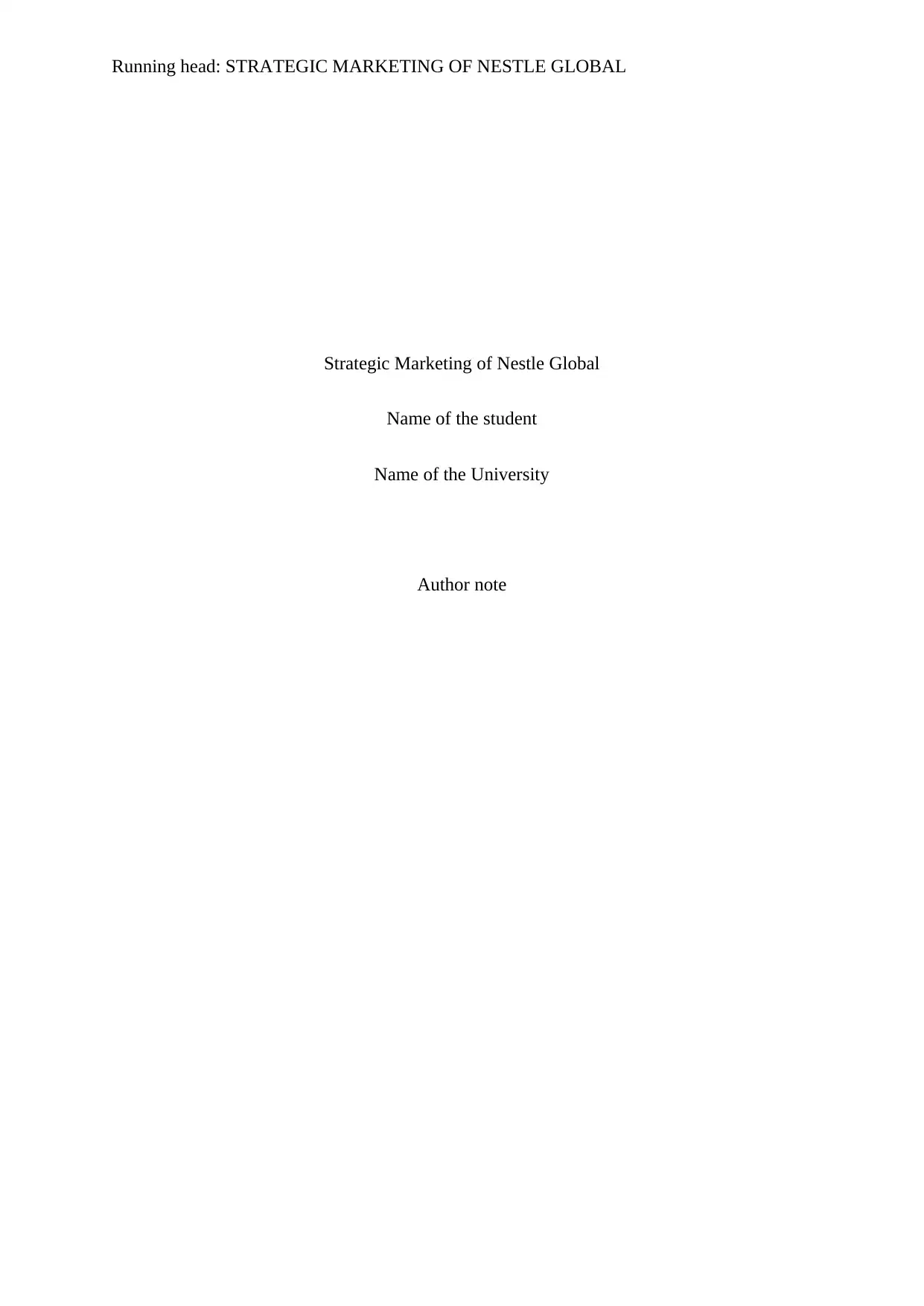
Running head: STRATEGIC MARKETING OF NESTLE GLOBAL
Strategic Marketing of Nestle Global
Name of the student
Name of the University
Author note
Strategic Marketing of Nestle Global
Name of the student
Name of the University
Author note
Secure Best Marks with AI Grader
Need help grading? Try our AI Grader for instant feedback on your assignments.
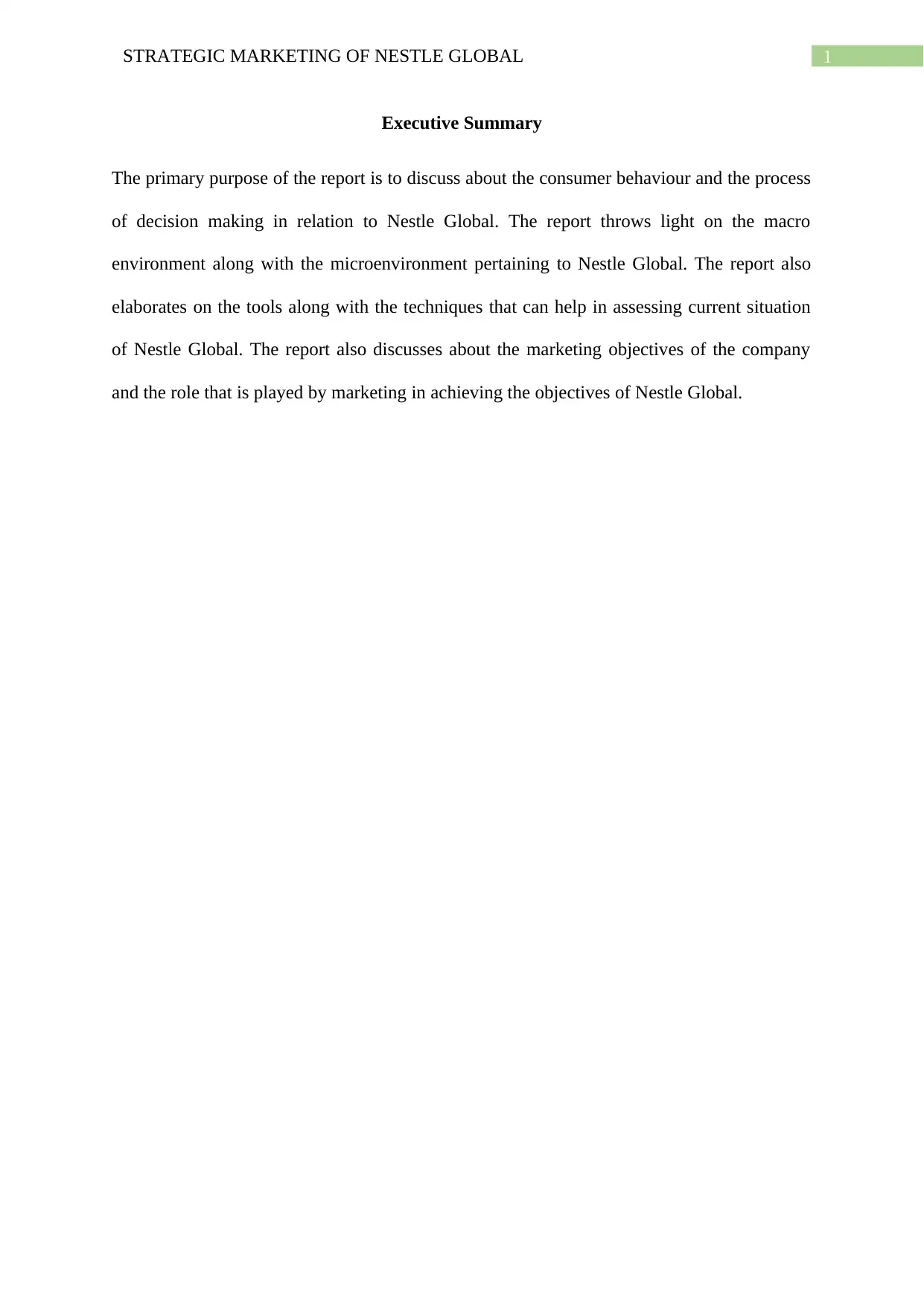
1STRATEGIC MARKETING OF NESTLE GLOBAL
Executive Summary
The primary purpose of the report is to discuss about the consumer behaviour and the process
of decision making in relation to Nestle Global. The report throws light on the macro
environment along with the microenvironment pertaining to Nestle Global. The report also
elaborates on the tools along with the techniques that can help in assessing current situation
of Nestle Global. The report also discusses about the marketing objectives of the company
and the role that is played by marketing in achieving the objectives of Nestle Global.
Executive Summary
The primary purpose of the report is to discuss about the consumer behaviour and the process
of decision making in relation to Nestle Global. The report throws light on the macro
environment along with the microenvironment pertaining to Nestle Global. The report also
elaborates on the tools along with the techniques that can help in assessing current situation
of Nestle Global. The report also discusses about the marketing objectives of the company
and the role that is played by marketing in achieving the objectives of Nestle Global.
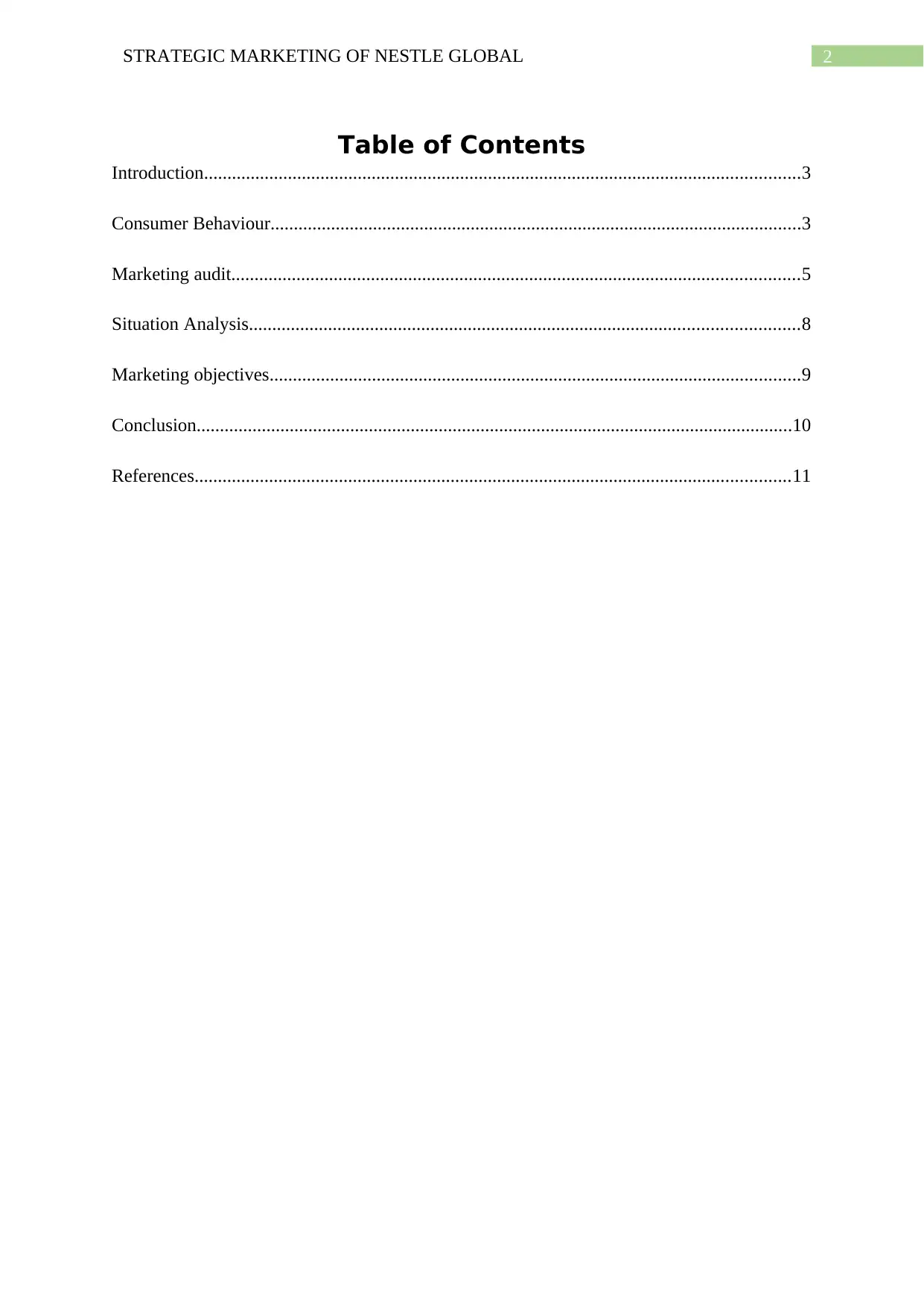
2STRATEGIC MARKETING OF NESTLE GLOBAL
Table of Contents
Introduction................................................................................................................................3
Consumer Behaviour..................................................................................................................3
Marketing audit..........................................................................................................................5
Situation Analysis......................................................................................................................8
Marketing objectives..................................................................................................................9
Conclusion................................................................................................................................10
References................................................................................................................................11
Table of Contents
Introduction................................................................................................................................3
Consumer Behaviour..................................................................................................................3
Marketing audit..........................................................................................................................5
Situation Analysis......................................................................................................................8
Marketing objectives..................................................................................................................9
Conclusion................................................................................................................................10
References................................................................................................................................11
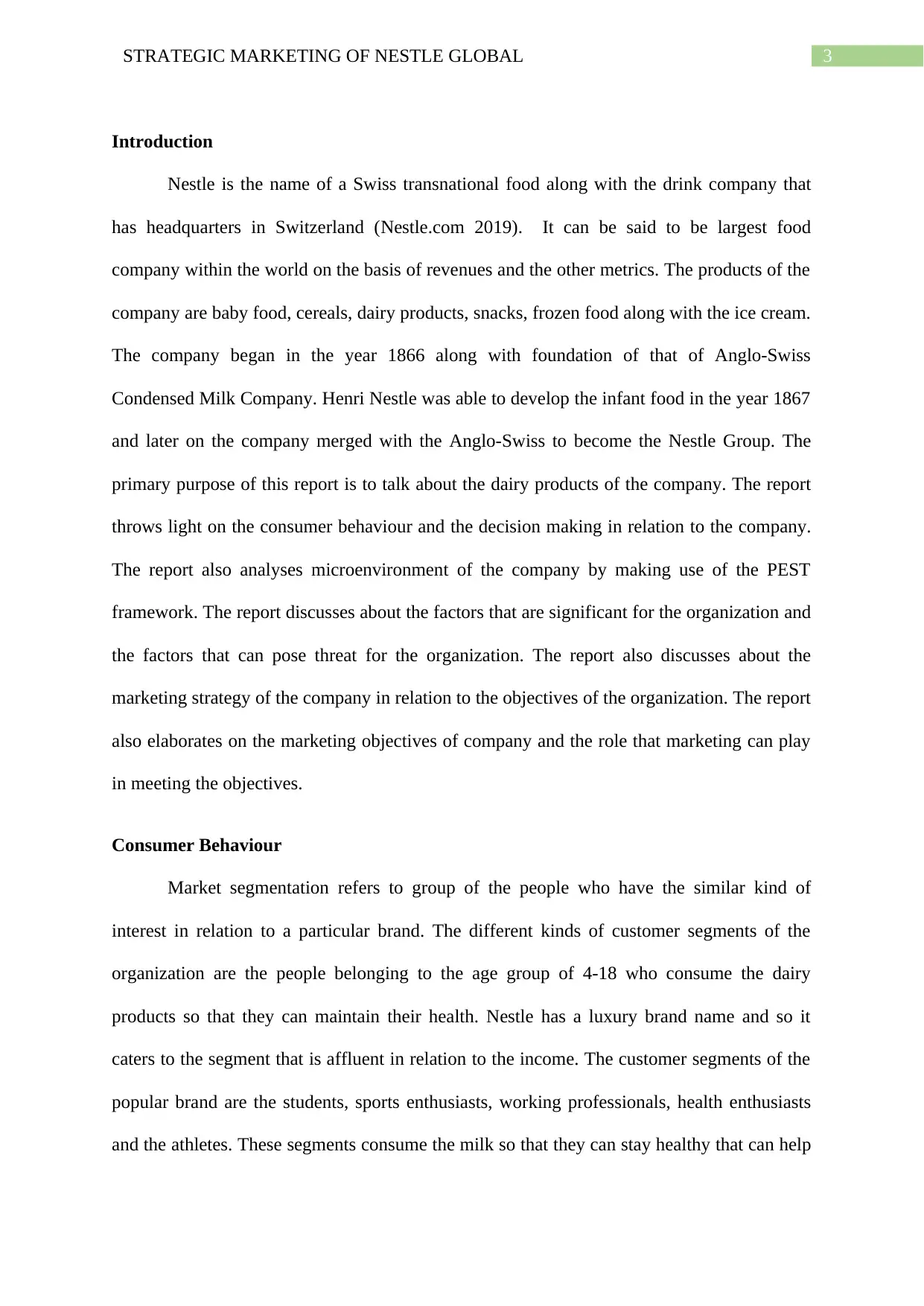
3STRATEGIC MARKETING OF NESTLE GLOBAL
Introduction
Nestle is the name of a Swiss transnational food along with the drink company that
has headquarters in Switzerland (Nestle.com 2019). It can be said to be largest food
company within the world on the basis of revenues and the other metrics. The products of the
company are baby food, cereals, dairy products, snacks, frozen food along with the ice cream.
The company began in the year 1866 along with foundation of that of Anglo-Swiss
Condensed Milk Company. Henri Nestle was able to develop the infant food in the year 1867
and later on the company merged with the Anglo-Swiss to become the Nestle Group. The
primary purpose of this report is to talk about the dairy products of the company. The report
throws light on the consumer behaviour and the decision making in relation to the company.
The report also analyses microenvironment of the company by making use of the PEST
framework. The report discusses about the factors that are significant for the organization and
the factors that can pose threat for the organization. The report also discusses about the
marketing strategy of the company in relation to the objectives of the organization. The report
also elaborates on the marketing objectives of company and the role that marketing can play
in meeting the objectives.
Consumer Behaviour
Market segmentation refers to group of the people who have the similar kind of
interest in relation to a particular brand. The different kinds of customer segments of the
organization are the people belonging to the age group of 4-18 who consume the dairy
products so that they can maintain their health. Nestle has a luxury brand name and so it
caters to the segment that is affluent in relation to the income. The customer segments of the
popular brand are the students, sports enthusiasts, working professionals, health enthusiasts
and the athletes. These segments consume the milk so that they can stay healthy that can help
Introduction
Nestle is the name of a Swiss transnational food along with the drink company that
has headquarters in Switzerland (Nestle.com 2019). It can be said to be largest food
company within the world on the basis of revenues and the other metrics. The products of the
company are baby food, cereals, dairy products, snacks, frozen food along with the ice cream.
The company began in the year 1866 along with foundation of that of Anglo-Swiss
Condensed Milk Company. Henri Nestle was able to develop the infant food in the year 1867
and later on the company merged with the Anglo-Swiss to become the Nestle Group. The
primary purpose of this report is to talk about the dairy products of the company. The report
throws light on the consumer behaviour and the decision making in relation to the company.
The report also analyses microenvironment of the company by making use of the PEST
framework. The report discusses about the factors that are significant for the organization and
the factors that can pose threat for the organization. The report also discusses about the
marketing strategy of the company in relation to the objectives of the organization. The report
also elaborates on the marketing objectives of company and the role that marketing can play
in meeting the objectives.
Consumer Behaviour
Market segmentation refers to group of the people who have the similar kind of
interest in relation to a particular brand. The different kinds of customer segments of the
organization are the people belonging to the age group of 4-18 who consume the dairy
products so that they can maintain their health. Nestle has a luxury brand name and so it
caters to the segment that is affluent in relation to the income. The customer segments of the
popular brand are the students, sports enthusiasts, working professionals, health enthusiasts
and the athletes. These segments consume the milk so that they can stay healthy that can help
Secure Best Marks with AI Grader
Need help grading? Try our AI Grader for instant feedback on your assignments.
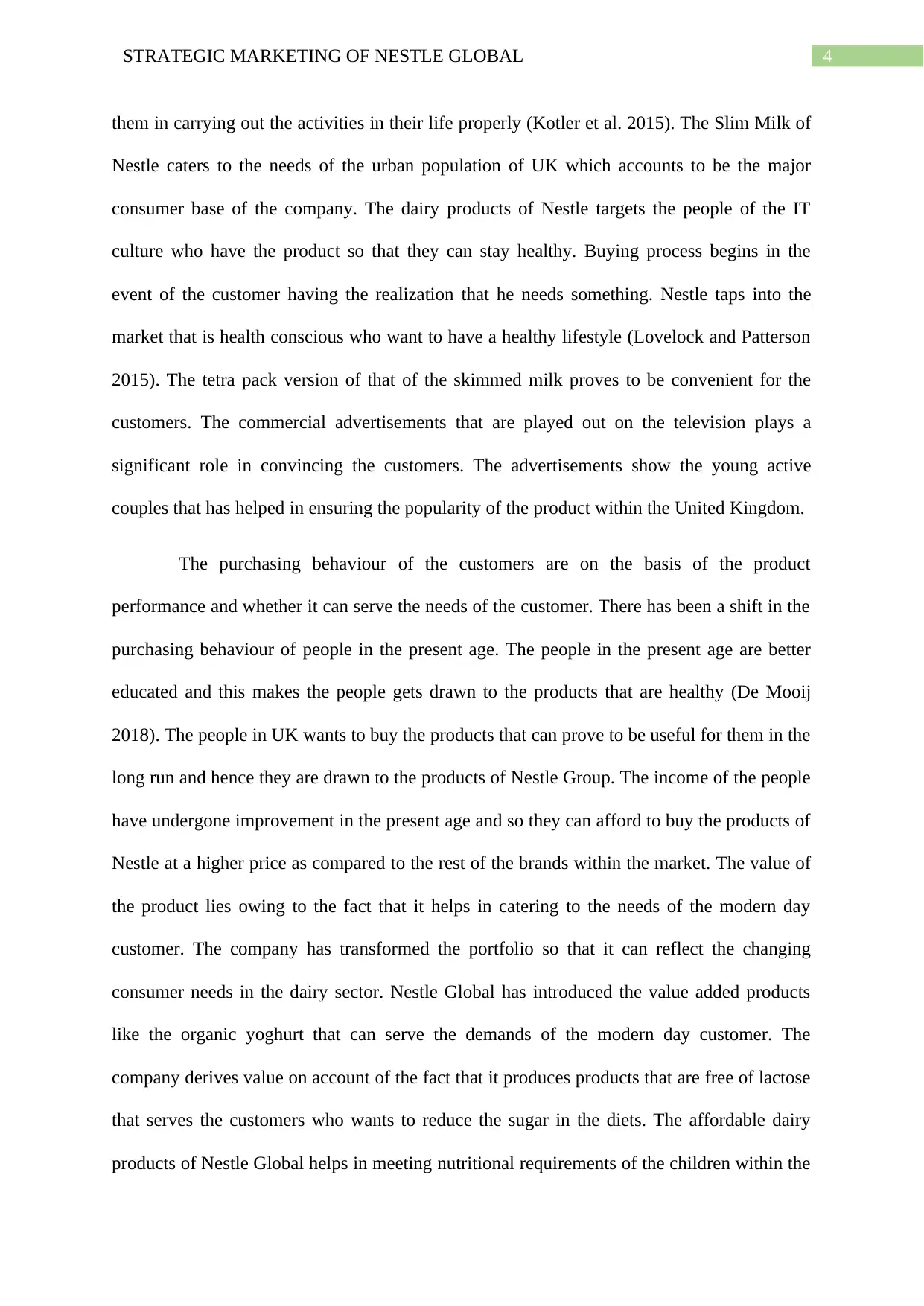
4STRATEGIC MARKETING OF NESTLE GLOBAL
them in carrying out the activities in their life properly (Kotler et al. 2015). The Slim Milk of
Nestle caters to the needs of the urban population of UK which accounts to be the major
consumer base of the company. The dairy products of Nestle targets the people of the IT
culture who have the product so that they can stay healthy. Buying process begins in the
event of the customer having the realization that he needs something. Nestle taps into the
market that is health conscious who want to have a healthy lifestyle (Lovelock and Patterson
2015). The tetra pack version of that of the skimmed milk proves to be convenient for the
customers. The commercial advertisements that are played out on the television plays a
significant role in convincing the customers. The advertisements show the young active
couples that has helped in ensuring the popularity of the product within the United Kingdom.
The purchasing behaviour of the customers are on the basis of the product
performance and whether it can serve the needs of the customer. There has been a shift in the
purchasing behaviour of people in the present age. The people in the present age are better
educated and this makes the people gets drawn to the products that are healthy (De Mooij
2018). The people in UK wants to buy the products that can prove to be useful for them in the
long run and hence they are drawn to the products of Nestle Group. The income of the people
have undergone improvement in the present age and so they can afford to buy the products of
Nestle at a higher price as compared to the rest of the brands within the market. The value of
the product lies owing to the fact that it helps in catering to the needs of the modern day
customer. The company has transformed the portfolio so that it can reflect the changing
consumer needs in the dairy sector. Nestle Global has introduced the value added products
like the organic yoghurt that can serve the demands of the modern day customer. The
company derives value on account of the fact that it produces products that are free of lactose
that serves the customers who wants to reduce the sugar in the diets. The affordable dairy
products of Nestle Global helps in meeting nutritional requirements of the children within the
them in carrying out the activities in their life properly (Kotler et al. 2015). The Slim Milk of
Nestle caters to the needs of the urban population of UK which accounts to be the major
consumer base of the company. The dairy products of Nestle targets the people of the IT
culture who have the product so that they can stay healthy. Buying process begins in the
event of the customer having the realization that he needs something. Nestle taps into the
market that is health conscious who want to have a healthy lifestyle (Lovelock and Patterson
2015). The tetra pack version of that of the skimmed milk proves to be convenient for the
customers. The commercial advertisements that are played out on the television plays a
significant role in convincing the customers. The advertisements show the young active
couples that has helped in ensuring the popularity of the product within the United Kingdom.
The purchasing behaviour of the customers are on the basis of the product
performance and whether it can serve the needs of the customer. There has been a shift in the
purchasing behaviour of people in the present age. The people in the present age are better
educated and this makes the people gets drawn to the products that are healthy (De Mooij
2018). The people in UK wants to buy the products that can prove to be useful for them in the
long run and hence they are drawn to the products of Nestle Group. The income of the people
have undergone improvement in the present age and so they can afford to buy the products of
Nestle at a higher price as compared to the rest of the brands within the market. The value of
the product lies owing to the fact that it helps in catering to the needs of the modern day
customer. The company has transformed the portfolio so that it can reflect the changing
consumer needs in the dairy sector. Nestle Global has introduced the value added products
like the organic yoghurt that can serve the demands of the modern day customer. The
company derives value on account of the fact that it produces products that are free of lactose
that serves the customers who wants to reduce the sugar in the diets. The affordable dairy
products of Nestle Global helps in meeting nutritional requirements of the children within the
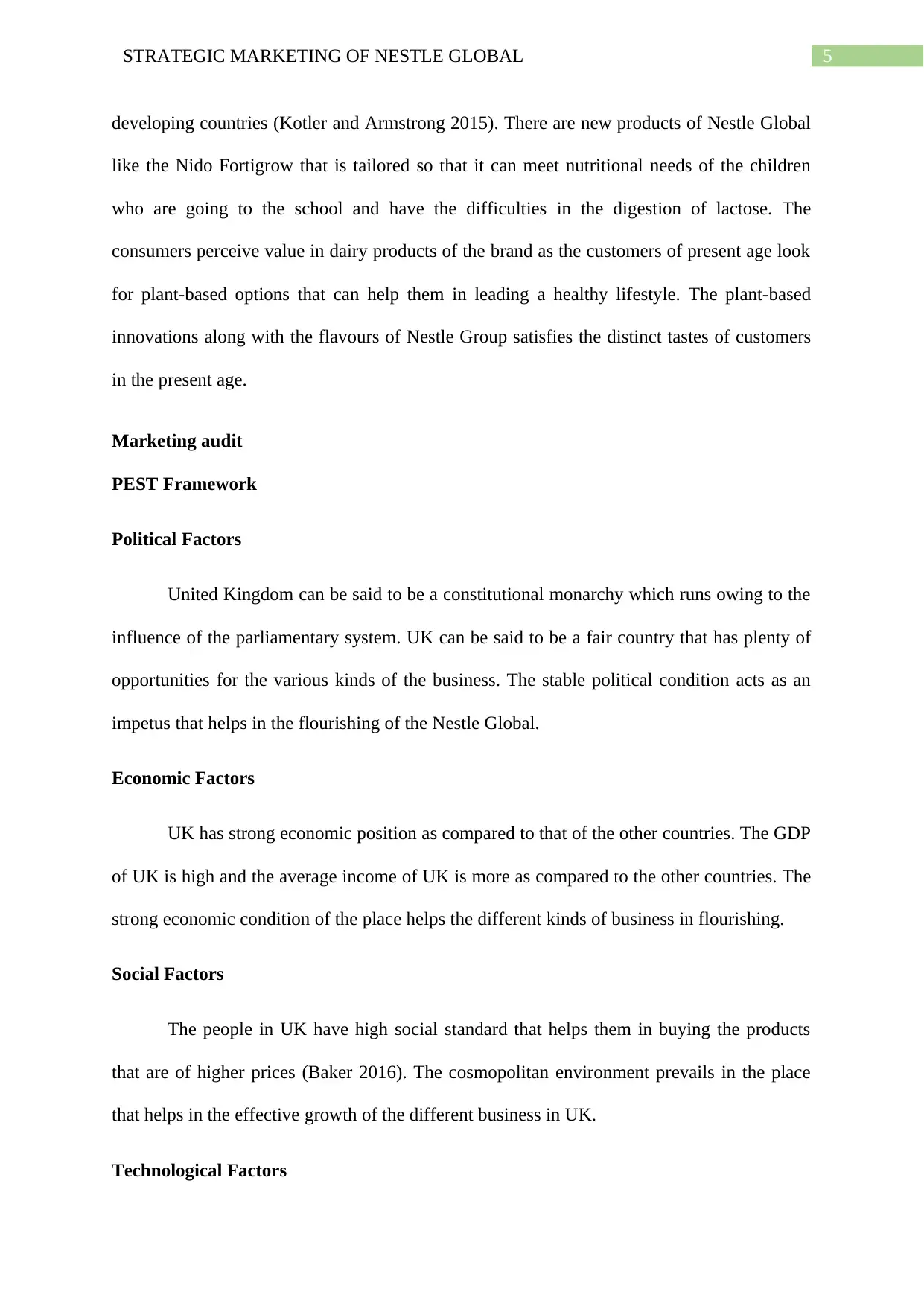
5STRATEGIC MARKETING OF NESTLE GLOBAL
developing countries (Kotler and Armstrong 2015). There are new products of Nestle Global
like the Nido Fortigrow that is tailored so that it can meet nutritional needs of the children
who are going to the school and have the difficulties in the digestion of lactose. The
consumers perceive value in dairy products of the brand as the customers of present age look
for plant-based options that can help them in leading a healthy lifestyle. The plant-based
innovations along with the flavours of Nestle Group satisfies the distinct tastes of customers
in the present age.
Marketing audit
PEST Framework
Political Factors
United Kingdom can be said to be a constitutional monarchy which runs owing to the
influence of the parliamentary system. UK can be said to be a fair country that has plenty of
opportunities for the various kinds of the business. The stable political condition acts as an
impetus that helps in the flourishing of the Nestle Global.
Economic Factors
UK has strong economic position as compared to that of the other countries. The GDP
of UK is high and the average income of UK is more as compared to the other countries. The
strong economic condition of the place helps the different kinds of business in flourishing.
Social Factors
The people in UK have high social standard that helps them in buying the products
that are of higher prices (Baker 2016). The cosmopolitan environment prevails in the place
that helps in the effective growth of the different business in UK.
Technological Factors
developing countries (Kotler and Armstrong 2015). There are new products of Nestle Global
like the Nido Fortigrow that is tailored so that it can meet nutritional needs of the children
who are going to the school and have the difficulties in the digestion of lactose. The
consumers perceive value in dairy products of the brand as the customers of present age look
for plant-based options that can help them in leading a healthy lifestyle. The plant-based
innovations along with the flavours of Nestle Group satisfies the distinct tastes of customers
in the present age.
Marketing audit
PEST Framework
Political Factors
United Kingdom can be said to be a constitutional monarchy which runs owing to the
influence of the parliamentary system. UK can be said to be a fair country that has plenty of
opportunities for the various kinds of the business. The stable political condition acts as an
impetus that helps in the flourishing of the Nestle Global.
Economic Factors
UK has strong economic position as compared to that of the other countries. The GDP
of UK is high and the average income of UK is more as compared to the other countries. The
strong economic condition of the place helps the different kinds of business in flourishing.
Social Factors
The people in UK have high social standard that helps them in buying the products
that are of higher prices (Baker 2016). The cosmopolitan environment prevails in the place
that helps in the effective growth of the different business in UK.
Technological Factors
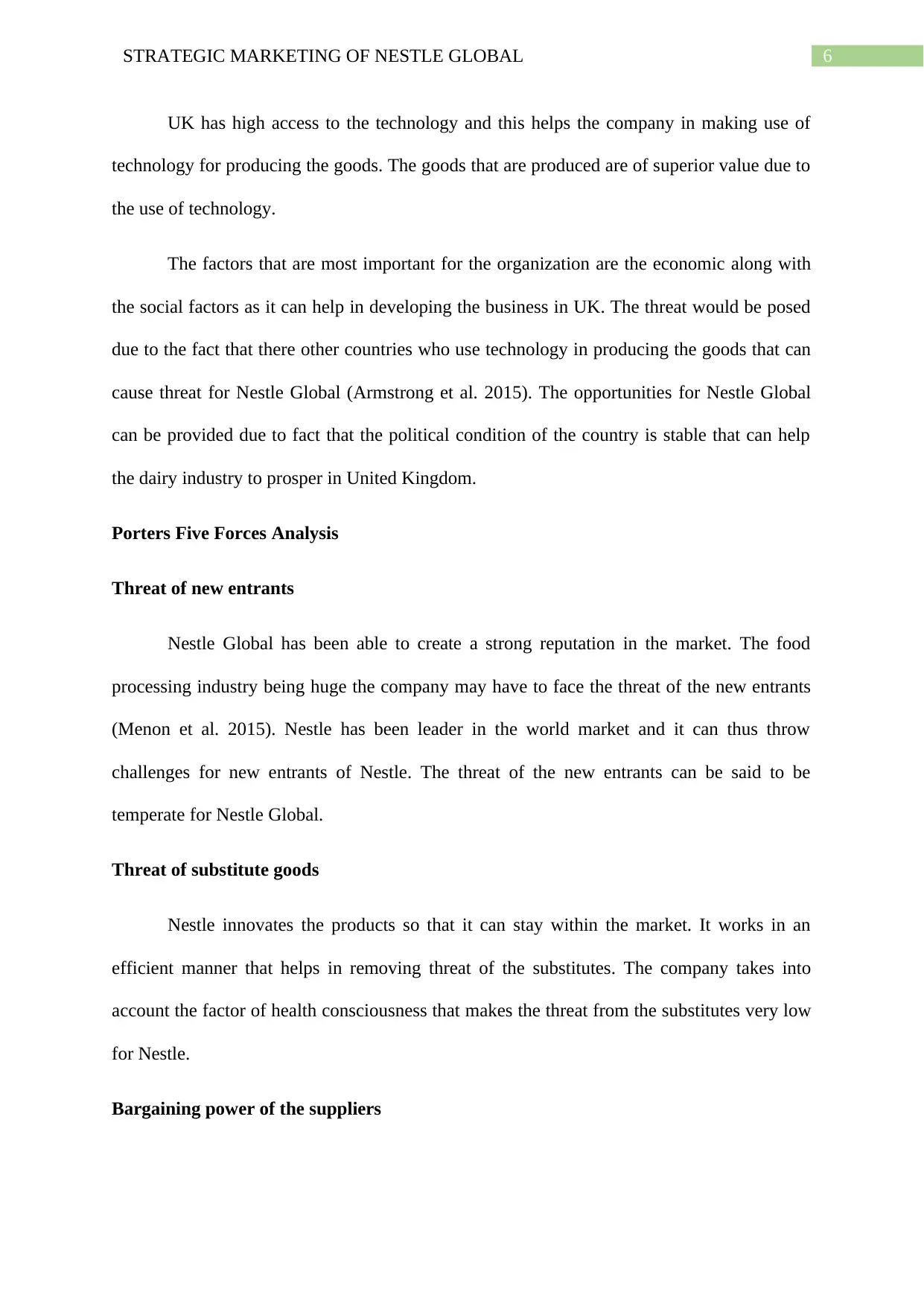
6STRATEGIC MARKETING OF NESTLE GLOBAL
UK has high access to the technology and this helps the company in making use of
technology for producing the goods. The goods that are produced are of superior value due to
the use of technology.
The factors that are most important for the organization are the economic along with
the social factors as it can help in developing the business in UK. The threat would be posed
due to the fact that there other countries who use technology in producing the goods that can
cause threat for Nestle Global (Armstrong et al. 2015). The opportunities for Nestle Global
can be provided due to fact that the political condition of the country is stable that can help
the dairy industry to prosper in United Kingdom.
Porters Five Forces Analysis
Threat of new entrants
Nestle Global has been able to create a strong reputation in the market. The food
processing industry being huge the company may have to face the threat of the new entrants
(Menon et al. 2015). Nestle has been leader in the world market and it can thus throw
challenges for new entrants of Nestle. The threat of the new entrants can be said to be
temperate for Nestle Global.
Threat of substitute goods
Nestle innovates the products so that it can stay within the market. It works in an
efficient manner that helps in removing threat of the substitutes. The company takes into
account the factor of health consciousness that makes the threat from the substitutes very low
for Nestle.
Bargaining power of the suppliers
UK has high access to the technology and this helps the company in making use of
technology for producing the goods. The goods that are produced are of superior value due to
the use of technology.
The factors that are most important for the organization are the economic along with
the social factors as it can help in developing the business in UK. The threat would be posed
due to the fact that there other countries who use technology in producing the goods that can
cause threat for Nestle Global (Armstrong et al. 2015). The opportunities for Nestle Global
can be provided due to fact that the political condition of the country is stable that can help
the dairy industry to prosper in United Kingdom.
Porters Five Forces Analysis
Threat of new entrants
Nestle Global has been able to create a strong reputation in the market. The food
processing industry being huge the company may have to face the threat of the new entrants
(Menon et al. 2015). Nestle has been leader in the world market and it can thus throw
challenges for new entrants of Nestle. The threat of the new entrants can be said to be
temperate for Nestle Global.
Threat of substitute goods
Nestle innovates the products so that it can stay within the market. It works in an
efficient manner that helps in removing threat of the substitutes. The company takes into
account the factor of health consciousness that makes the threat from the substitutes very low
for Nestle.
Bargaining power of the suppliers
Paraphrase This Document
Need a fresh take? Get an instant paraphrase of this document with our AI Paraphraser
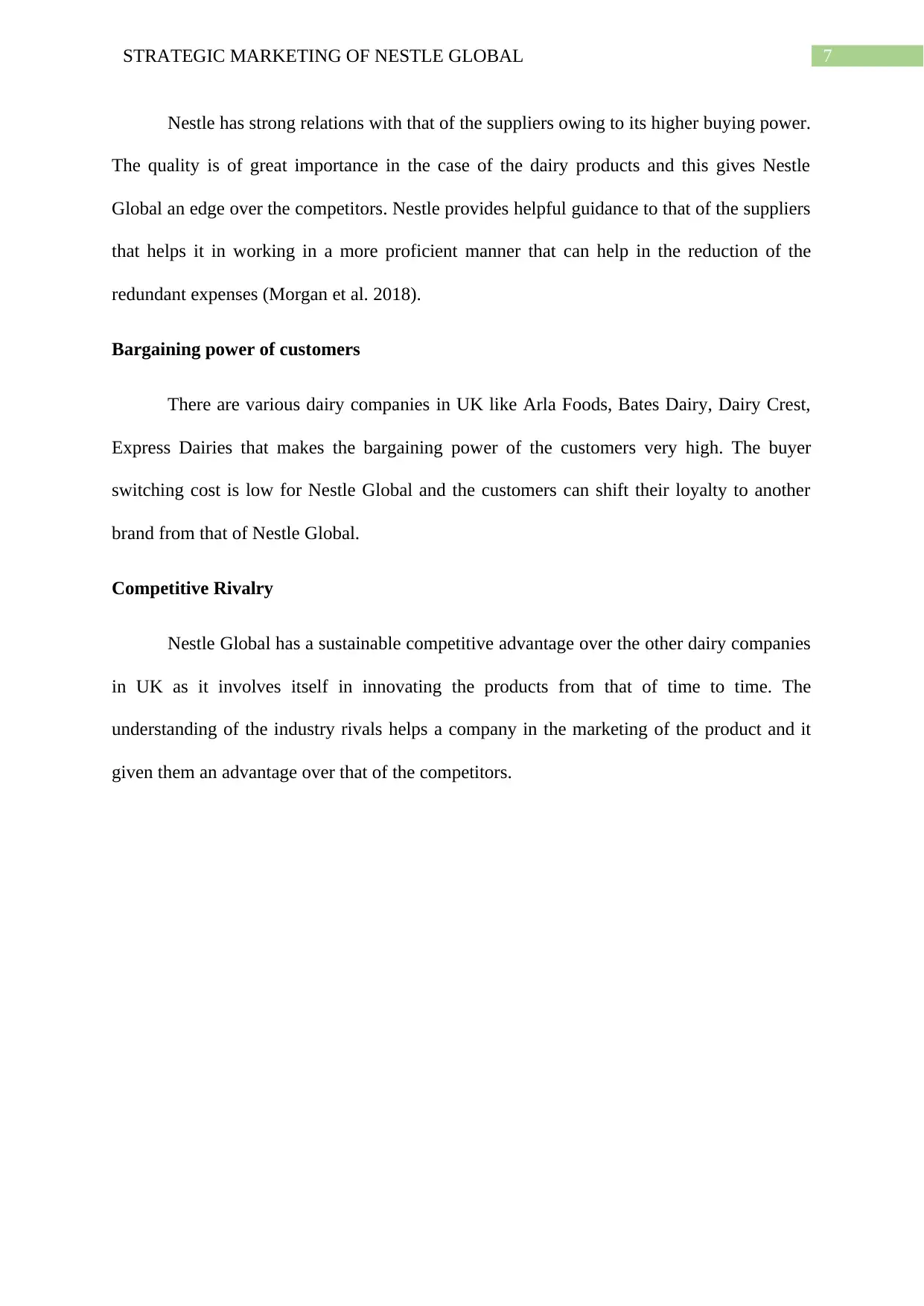
7STRATEGIC MARKETING OF NESTLE GLOBAL
Nestle has strong relations with that of the suppliers owing to its higher buying power.
The quality is of great importance in the case of the dairy products and this gives Nestle
Global an edge over the competitors. Nestle provides helpful guidance to that of the suppliers
that helps it in working in a more proficient manner that can help in the reduction of the
redundant expenses (Morgan et al. 2018).
Bargaining power of customers
There are various dairy companies in UK like Arla Foods, Bates Dairy, Dairy Crest,
Express Dairies that makes the bargaining power of the customers very high. The buyer
switching cost is low for Nestle Global and the customers can shift their loyalty to another
brand from that of Nestle Global.
Competitive Rivalry
Nestle Global has a sustainable competitive advantage over the other dairy companies
in UK as it involves itself in innovating the products from that of time to time. The
understanding of the industry rivals helps a company in the marketing of the product and it
given them an advantage over that of the competitors.
Nestle has strong relations with that of the suppliers owing to its higher buying power.
The quality is of great importance in the case of the dairy products and this gives Nestle
Global an edge over the competitors. Nestle provides helpful guidance to that of the suppliers
that helps it in working in a more proficient manner that can help in the reduction of the
redundant expenses (Morgan et al. 2018).
Bargaining power of customers
There are various dairy companies in UK like Arla Foods, Bates Dairy, Dairy Crest,
Express Dairies that makes the bargaining power of the customers very high. The buyer
switching cost is low for Nestle Global and the customers can shift their loyalty to another
brand from that of Nestle Global.
Competitive Rivalry
Nestle Global has a sustainable competitive advantage over the other dairy companies
in UK as it involves itself in innovating the products from that of time to time. The
understanding of the industry rivals helps a company in the marketing of the product and it
given them an advantage over that of the competitors.
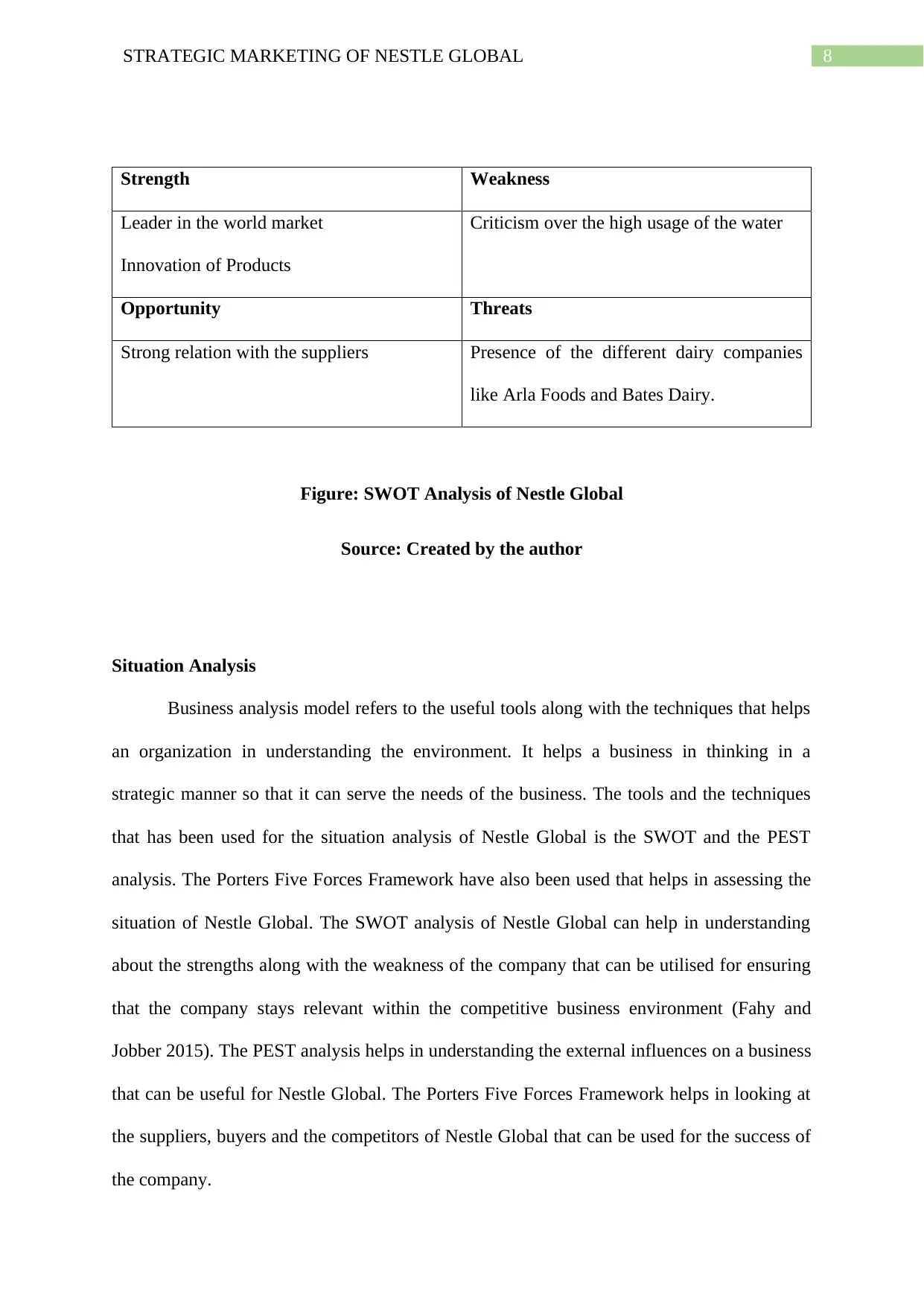
8STRATEGIC MARKETING OF NESTLE GLOBAL
Strength Weakness
Leader in the world market
Innovation of Products
Criticism over the high usage of the water
Opportunity Threats
Strong relation with the suppliers Presence of the different dairy companies
like Arla Foods and Bates Dairy.
Figure: SWOT Analysis of Nestle Global
Source: Created by the author
Situation Analysis
Business analysis model refers to the useful tools along with the techniques that helps
an organization in understanding the environment. It helps a business in thinking in a
strategic manner so that it can serve the needs of the business. The tools and the techniques
that has been used for the situation analysis of Nestle Global is the SWOT and the PEST
analysis. The Porters Five Forces Framework have also been used that helps in assessing the
situation of Nestle Global. The SWOT analysis of Nestle Global can help in understanding
about the strengths along with the weakness of the company that can be utilised for ensuring
that the company stays relevant within the competitive business environment (Fahy and
Jobber 2015). The PEST analysis helps in understanding the external influences on a business
that can be useful for Nestle Global. The Porters Five Forces Framework helps in looking at
the suppliers, buyers and the competitors of Nestle Global that can be used for the success of
the company.
Strength Weakness
Leader in the world market
Innovation of Products
Criticism over the high usage of the water
Opportunity Threats
Strong relation with the suppliers Presence of the different dairy companies
like Arla Foods and Bates Dairy.
Figure: SWOT Analysis of Nestle Global
Source: Created by the author
Situation Analysis
Business analysis model refers to the useful tools along with the techniques that helps
an organization in understanding the environment. It helps a business in thinking in a
strategic manner so that it can serve the needs of the business. The tools and the techniques
that has been used for the situation analysis of Nestle Global is the SWOT and the PEST
analysis. The Porters Five Forces Framework have also been used that helps in assessing the
situation of Nestle Global. The SWOT analysis of Nestle Global can help in understanding
about the strengths along with the weakness of the company that can be utilised for ensuring
that the company stays relevant within the competitive business environment (Fahy and
Jobber 2015). The PEST analysis helps in understanding the external influences on a business
that can be useful for Nestle Global. The Porters Five Forces Framework helps in looking at
the suppliers, buyers and the competitors of Nestle Global that can be used for the success of
the company.
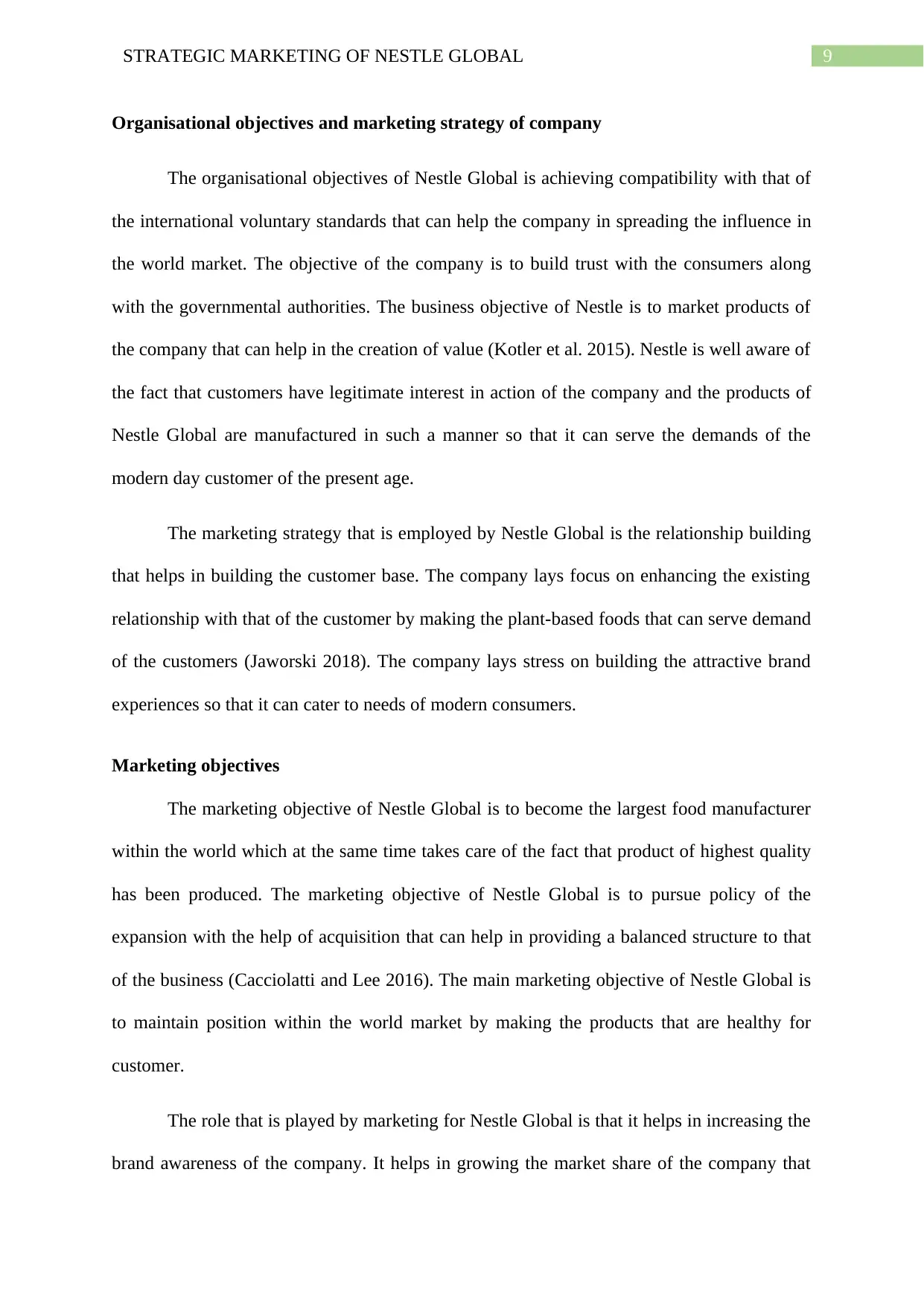
9STRATEGIC MARKETING OF NESTLE GLOBAL
Organisational objectives and marketing strategy of company
The organisational objectives of Nestle Global is achieving compatibility with that of
the international voluntary standards that can help the company in spreading the influence in
the world market. The objective of the company is to build trust with the consumers along
with the governmental authorities. The business objective of Nestle is to market products of
the company that can help in the creation of value (Kotler et al. 2015). Nestle is well aware of
the fact that customers have legitimate interest in action of the company and the products of
Nestle Global are manufactured in such a manner so that it can serve the demands of the
modern day customer of the present age.
The marketing strategy that is employed by Nestle Global is the relationship building
that helps in building the customer base. The company lays focus on enhancing the existing
relationship with that of the customer by making the plant-based foods that can serve demand
of the customers (Jaworski 2018). The company lays stress on building the attractive brand
experiences so that it can cater to needs of modern consumers.
Marketing objectives
The marketing objective of Nestle Global is to become the largest food manufacturer
within the world which at the same time takes care of the fact that product of highest quality
has been produced. The marketing objective of Nestle Global is to pursue policy of the
expansion with the help of acquisition that can help in providing a balanced structure to that
of the business (Cacciolatti and Lee 2016). The main marketing objective of Nestle Global is
to maintain position within the world market by making the products that are healthy for
customer.
The role that is played by marketing for Nestle Global is that it helps in increasing the
brand awareness of the company. It helps in growing the market share of the company that
Organisational objectives and marketing strategy of company
The organisational objectives of Nestle Global is achieving compatibility with that of
the international voluntary standards that can help the company in spreading the influence in
the world market. The objective of the company is to build trust with the consumers along
with the governmental authorities. The business objective of Nestle is to market products of
the company that can help in the creation of value (Kotler et al. 2015). Nestle is well aware of
the fact that customers have legitimate interest in action of the company and the products of
Nestle Global are manufactured in such a manner so that it can serve the demands of the
modern day customer of the present age.
The marketing strategy that is employed by Nestle Global is the relationship building
that helps in building the customer base. The company lays focus on enhancing the existing
relationship with that of the customer by making the plant-based foods that can serve demand
of the customers (Jaworski 2018). The company lays stress on building the attractive brand
experiences so that it can cater to needs of modern consumers.
Marketing objectives
The marketing objective of Nestle Global is to become the largest food manufacturer
within the world which at the same time takes care of the fact that product of highest quality
has been produced. The marketing objective of Nestle Global is to pursue policy of the
expansion with the help of acquisition that can help in providing a balanced structure to that
of the business (Cacciolatti and Lee 2016). The main marketing objective of Nestle Global is
to maintain position within the world market by making the products that are healthy for
customer.
The role that is played by marketing for Nestle Global is that it helps in increasing the
brand awareness of the company. It helps in growing the market share of the company that
Secure Best Marks with AI Grader
Need help grading? Try our AI Grader for instant feedback on your assignments.
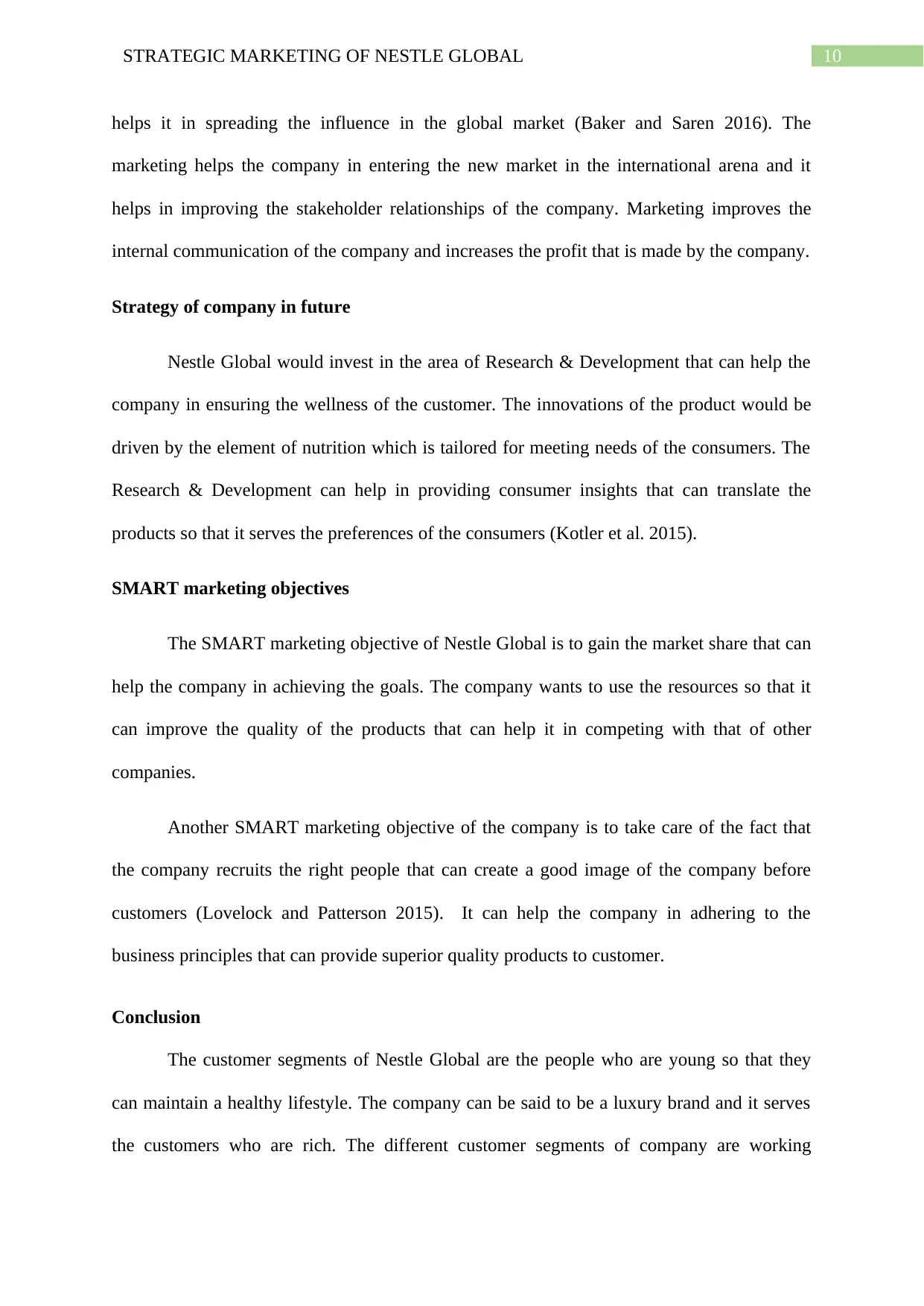
10STRATEGIC MARKETING OF NESTLE GLOBAL
helps it in spreading the influence in the global market (Baker and Saren 2016). The
marketing helps the company in entering the new market in the international arena and it
helps in improving the stakeholder relationships of the company. Marketing improves the
internal communication of the company and increases the profit that is made by the company.
Strategy of company in future
Nestle Global would invest in the area of Research & Development that can help the
company in ensuring the wellness of the customer. The innovations of the product would be
driven by the element of nutrition which is tailored for meeting needs of the consumers. The
Research & Development can help in providing consumer insights that can translate the
products so that it serves the preferences of the consumers (Kotler et al. 2015).
SMART marketing objectives
The SMART marketing objective of Nestle Global is to gain the market share that can
help the company in achieving the goals. The company wants to use the resources so that it
can improve the quality of the products that can help it in competing with that of other
companies.
Another SMART marketing objective of the company is to take care of the fact that
the company recruits the right people that can create a good image of the company before
customers (Lovelock and Patterson 2015). It can help the company in adhering to the
business principles that can provide superior quality products to customer.
Conclusion
The customer segments of Nestle Global are the people who are young so that they
can maintain a healthy lifestyle. The company can be said to be a luxury brand and it serves
the customers who are rich. The different customer segments of company are working
helps it in spreading the influence in the global market (Baker and Saren 2016). The
marketing helps the company in entering the new market in the international arena and it
helps in improving the stakeholder relationships of the company. Marketing improves the
internal communication of the company and increases the profit that is made by the company.
Strategy of company in future
Nestle Global would invest in the area of Research & Development that can help the
company in ensuring the wellness of the customer. The innovations of the product would be
driven by the element of nutrition which is tailored for meeting needs of the consumers. The
Research & Development can help in providing consumer insights that can translate the
products so that it serves the preferences of the consumers (Kotler et al. 2015).
SMART marketing objectives
The SMART marketing objective of Nestle Global is to gain the market share that can
help the company in achieving the goals. The company wants to use the resources so that it
can improve the quality of the products that can help it in competing with that of other
companies.
Another SMART marketing objective of the company is to take care of the fact that
the company recruits the right people that can create a good image of the company before
customers (Lovelock and Patterson 2015). It can help the company in adhering to the
business principles that can provide superior quality products to customer.
Conclusion
The customer segments of Nestle Global are the people who are young so that they
can maintain a healthy lifestyle. The company can be said to be a luxury brand and it serves
the customers who are rich. The different customer segments of company are working
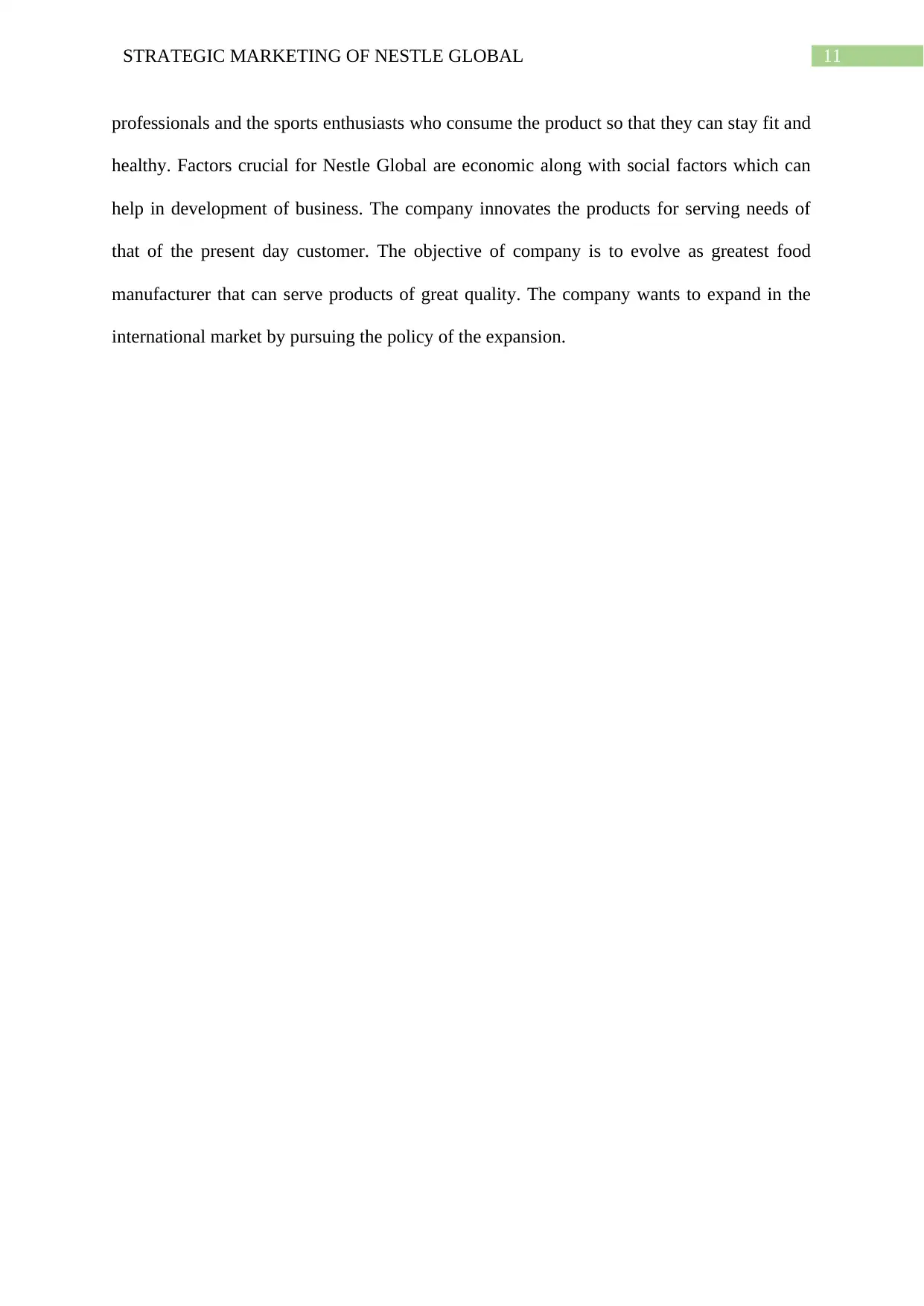
11STRATEGIC MARKETING OF NESTLE GLOBAL
professionals and the sports enthusiasts who consume the product so that they can stay fit and
healthy. Factors crucial for Nestle Global are economic along with social factors which can
help in development of business. The company innovates the products for serving needs of
that of the present day customer. The objective of company is to evolve as greatest food
manufacturer that can serve products of great quality. The company wants to expand in the
international market by pursuing the policy of the expansion.
professionals and the sports enthusiasts who consume the product so that they can stay fit and
healthy. Factors crucial for Nestle Global are economic along with social factors which can
help in development of business. The company innovates the products for serving needs of
that of the present day customer. The objective of company is to evolve as greatest food
manufacturer that can serve products of great quality. The company wants to expand in the
international market by pursuing the policy of the expansion.
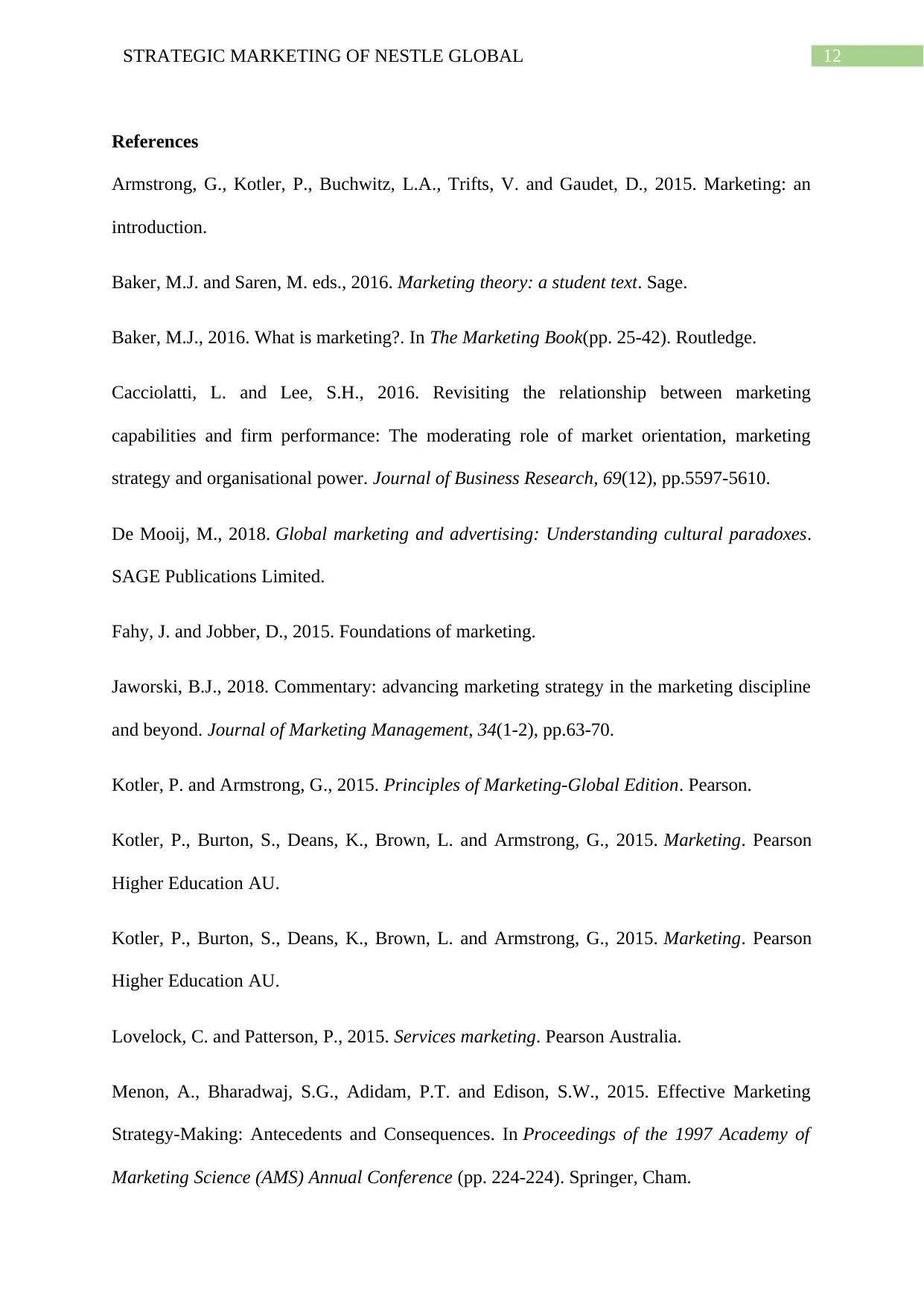
12STRATEGIC MARKETING OF NESTLE GLOBAL
References
Armstrong, G., Kotler, P., Buchwitz, L.A., Trifts, V. and Gaudet, D., 2015. Marketing: an
introduction.
Baker, M.J. and Saren, M. eds., 2016. Marketing theory: a student text. Sage.
Baker, M.J., 2016. What is marketing?. In The Marketing Book(pp. 25-42). Routledge.
Cacciolatti, L. and Lee, S.H., 2016. Revisiting the relationship between marketing
capabilities and firm performance: The moderating role of market orientation, marketing
strategy and organisational power. Journal of Business Research, 69(12), pp.5597-5610.
De Mooij, M., 2018. Global marketing and advertising: Understanding cultural paradoxes.
SAGE Publications Limited.
Fahy, J. and Jobber, D., 2015. Foundations of marketing.
Jaworski, B.J., 2018. Commentary: advancing marketing strategy in the marketing discipline
and beyond. Journal of Marketing Management, 34(1-2), pp.63-70.
Kotler, P. and Armstrong, G., 2015. Principles of Marketing-Global Edition. Pearson.
Kotler, P., Burton, S., Deans, K., Brown, L. and Armstrong, G., 2015. Marketing. Pearson
Higher Education AU.
Kotler, P., Burton, S., Deans, K., Brown, L. and Armstrong, G., 2015. Marketing. Pearson
Higher Education AU.
Lovelock, C. and Patterson, P., 2015. Services marketing. Pearson Australia.
Menon, A., Bharadwaj, S.G., Adidam, P.T. and Edison, S.W., 2015. Effective Marketing
Strategy-Making: Antecedents and Consequences. In Proceedings of the 1997 Academy of
Marketing Science (AMS) Annual Conference (pp. 224-224). Springer, Cham.
References
Armstrong, G., Kotler, P., Buchwitz, L.A., Trifts, V. and Gaudet, D., 2015. Marketing: an
introduction.
Baker, M.J. and Saren, M. eds., 2016. Marketing theory: a student text. Sage.
Baker, M.J., 2016. What is marketing?. In The Marketing Book(pp. 25-42). Routledge.
Cacciolatti, L. and Lee, S.H., 2016. Revisiting the relationship between marketing
capabilities and firm performance: The moderating role of market orientation, marketing
strategy and organisational power. Journal of Business Research, 69(12), pp.5597-5610.
De Mooij, M., 2018. Global marketing and advertising: Understanding cultural paradoxes.
SAGE Publications Limited.
Fahy, J. and Jobber, D., 2015. Foundations of marketing.
Jaworski, B.J., 2018. Commentary: advancing marketing strategy in the marketing discipline
and beyond. Journal of Marketing Management, 34(1-2), pp.63-70.
Kotler, P. and Armstrong, G., 2015. Principles of Marketing-Global Edition. Pearson.
Kotler, P., Burton, S., Deans, K., Brown, L. and Armstrong, G., 2015. Marketing. Pearson
Higher Education AU.
Kotler, P., Burton, S., Deans, K., Brown, L. and Armstrong, G., 2015. Marketing. Pearson
Higher Education AU.
Lovelock, C. and Patterson, P., 2015. Services marketing. Pearson Australia.
Menon, A., Bharadwaj, S.G., Adidam, P.T. and Edison, S.W., 2015. Effective Marketing
Strategy-Making: Antecedents and Consequences. In Proceedings of the 1997 Academy of
Marketing Science (AMS) Annual Conference (pp. 224-224). Springer, Cham.
Paraphrase This Document
Need a fresh take? Get an instant paraphrase of this document with our AI Paraphraser
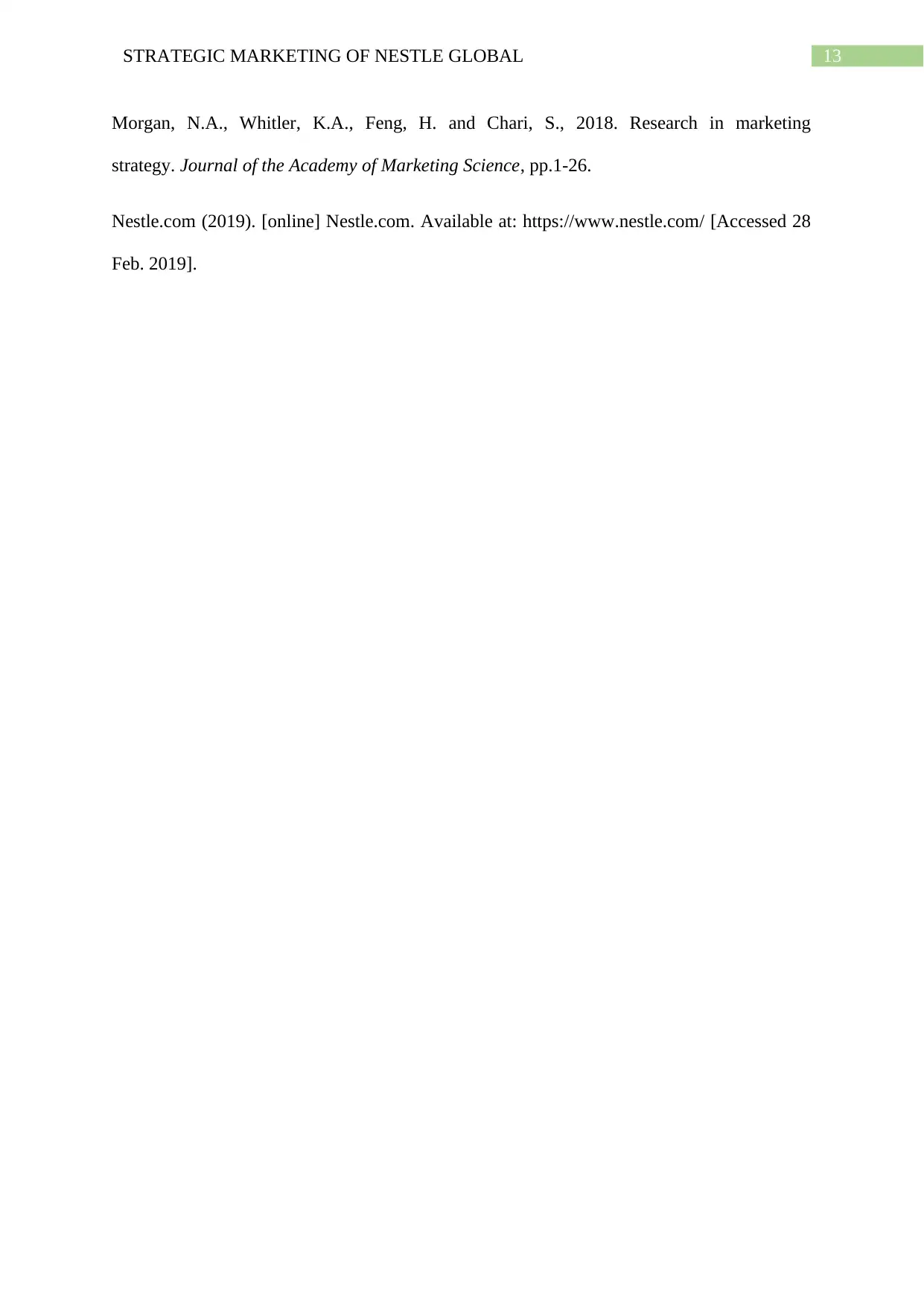
13STRATEGIC MARKETING OF NESTLE GLOBAL
Morgan, N.A., Whitler, K.A., Feng, H. and Chari, S., 2018. Research in marketing
strategy. Journal of the Academy of Marketing Science, pp.1-26.
Nestle.com (2019). [online] Nestle.com. Available at: https://www.nestle.com/ [Accessed 28
Feb. 2019].
Morgan, N.A., Whitler, K.A., Feng, H. and Chari, S., 2018. Research in marketing
strategy. Journal of the Academy of Marketing Science, pp.1-26.
Nestle.com (2019). [online] Nestle.com. Available at: https://www.nestle.com/ [Accessed 28
Feb. 2019].
1 out of 14
Related Documents
Your All-in-One AI-Powered Toolkit for Academic Success.
+13062052269
info@desklib.com
Available 24*7 on WhatsApp / Email
![[object Object]](/_next/static/media/star-bottom.7253800d.svg)
Unlock your academic potential
© 2024 | Zucol Services PVT LTD | All rights reserved.



